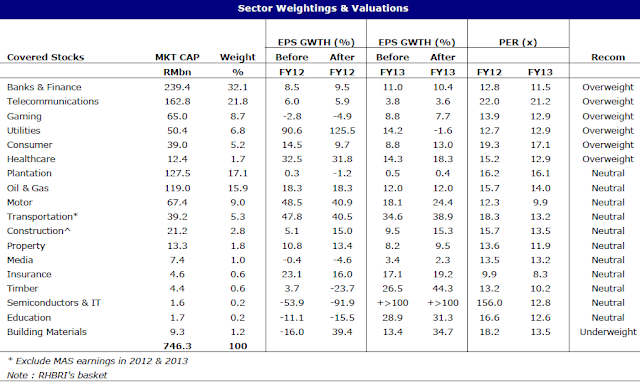General election is around the corner. External environment was not so promising, following the no ending of European debt crisis, world economic slowdown, and recent tension between China and Japan. I believe all of these would be some key factors being taking into consideration to formulate the Malaysia Budget 2013.
Goodies? Bonus? Cash handout?
Themed as "Prospering The Nation, Enhancing Well-Being of the Rakyat: A Promise Fulfilled". Our prime minister, who is also Finance Minister, tabled the 2013 Budget at Dewan Rakyat yesterday. Over here, Finance Malaysia blog would only touches on some key points:
- Economic growth projected to expand between 4.5% - 5.5%
- Federal Government's revenue in 2013 is estimated to increase to RM208.6 billion
- Continuation of BR1M of RM500 to households earning not more than RM3,000 a month and also extended the aid to cover a payment of RM250 for single unmarried individuals aged 21 and above, earnings not more than RM2,000 a month
- RM 16 million a year group insurance scheme for registered hawkers and small businesses for coverage of up to RM5,000
- FM: Once again goodies were dished out to created a feel-good factor for govt and we doubted whether Msia could achieves the 4% budget deficit target in 2013. Anyway, govt could still succeed by increasing the revenue by using these goodies. How? Very simple, that's to entice the non-registered self-employed and businesses to registered so that they are accountable for their earnings.
Spurring retail bond/sukuk market:
- DanaInfra Nasional Bhd to issue retail bonds worth RM300million by end-2012 to finance MRT development projects
- Additional expenses incurred in issuance of retail bonds and retail sukuk to be given double deduction for a period of 4 years from YA2012 to YA2015
- Individuals investors given stamp duty exemption on instruments relating to transactions of retail bonds and retail sukuk
- FM: It's very clear and straight forward that the govt want to see the soon-to-be launched retail bond/sukuk market to prosper, thus, attracting more foreign funds to the country to make it more vibrant and liquid.
Youth-centric offers:
- A one-off rebate of RM200 for the purchase of one unit of 3G smartphone from authorized dealers for youths aged between 21 to 30 years old with monthly income of RM3,000 and below.
- PTPTN loans: 20% discount for full repayment of loan; 10% discount for regular repayment.
- RM250 1Malaysia book voucher for students studying at institutions of higher learning
- FM: It seems too good to be true for PTPTN borrowers. But, it was attractive for probably 1% of them only. Why? We must remember that they borrow because they doesn't have money in the first place, not because they want to leverage. Do you get my meaning? Or, does govt scared if opposition coalition will void all outstanding loans if they took over?
Addressing the skyrocketing property prices:
- RM500 million by PR1MA to build 80,000 houses in major locations nationwide with selling price ranging between RM100,000 and RM400,000 per unit. Among the locations are KL, Shah Alam, JB, Seremban and Kuantan.
- MyFirst Home Scheme will be enhanced by increasing the income limit for individual loans from RM3,000 to RM5,000 per month or joint loans of husband and wife of up to RM10,000 per month.
- Real Property Gains Tax (RPGT) for properties disposed within 2 years will be taxed at 15% (up from 10%) and 10% for between 3rd to 5th year (up from 5%), whereas other term remained unchanged.
- FM: For us, we think that 15% RPGT is still too low if compared to pre-2007, where RPGT for first 2 years disposal was as high as 30% and 25%. Meanwhile, MyFirst Home Scheme was very tough to get it, as far as we concerned. Once again, good luck to those potential property buyers.
Changes to personal income tax:
- Individual income tax rate to be reduced by 1% for each grouped annual income tax exceeding RM2,500 and RM50,000.
- Tax relief on children's higher education scheme (SPNN) increased to RM6,000 per person (from RM4,000 previously).
- FM: The 1% tax reduction seems more effective to help out those mid-income earners, although it's not much. However, we are disappointed once again for the unchanged REITs withholding tax structure which makes M-REITs less attractive compared to regional REITs.
Government servants is the BIG winner AGAIN!!!
- Minimum pension to be increased to RM820 for those who had served the govt for at least 25 years. More than 50,000 pensioners benefited.
- 1.5 months bonus for civil servants.
- FM: Well... Nothing much we can say about it. This is a govt budget. What's wrong if govt servants being the beneficiary? But, should it be again and again? Hmmm...
"Stocks-to-watch" for the coming Monday:
- Genting, GENM, JTI, BAT on the surprise unchanged sin taxes
- Construction companies on the River of Life projects, EPP projects and schools upgrade
- Consumer related players on the expected extra spending by govt servants with bonuses
- Low cost housing developers (etc. Hua Yang) for possible contracts by PR1MA
- Financial institutions with investment banking arm for the launching of retail bond/sukuk market



















